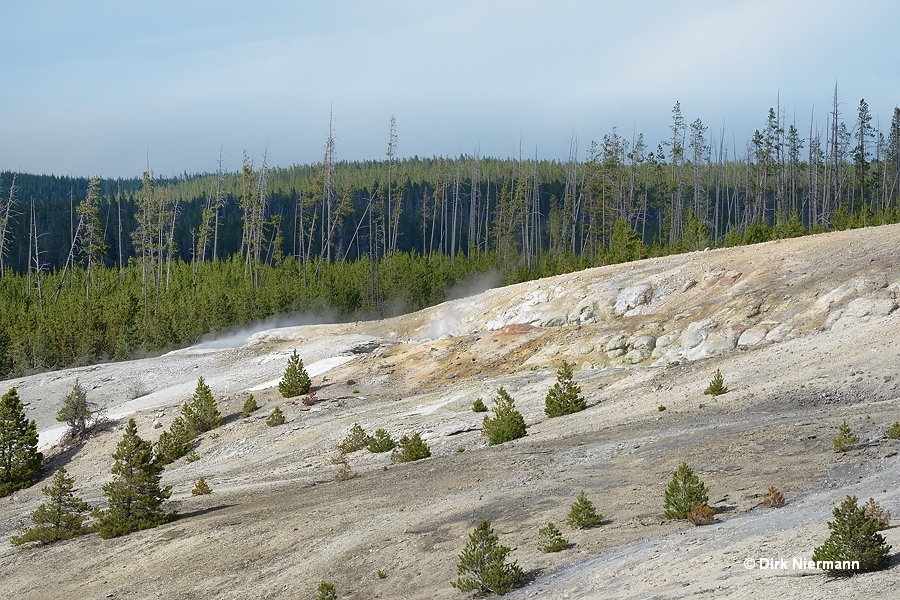Distant geysers on the flat of Norris Porcelain Basin
The flat of Norris Porcelain Basin between the Poreclain Springs and Pinwheel Geyser is home of a huge, rapidly varying number of geysers and perpetual spouters, whose sizes often are underestimated due to the large distance to the boardwalk. Some features on the flat are rather short-living, others are persisting for many years or decades, but overall the area exhibits high dynamics. All of these are reasons that only very few features in this area are officially named, such as Blue Geyser and Iris Spring. Others, like Feisty Geyser, did carry a name but disappeared or can no longer be positively identified.
Only few visitors take time to look out for the numerous geysers and perpetual spouters on the flat further beyond the Porcelain Springs. Even when many of these features do only exist for a short period of time, some of them are in terms of colors, frequency, or height of eruptions in no way inferior to other, far more prominent geysers. But the distance from the trail and steam do often impede the view.
Far out on the sinter flat the small Iris Spring and Blue Geyser are rare examples of features with a continuance over many decades. Both are mostly active during a disturbance. Prior to 1933 Iris Spring carried the name Apple Green Geyser for some time.
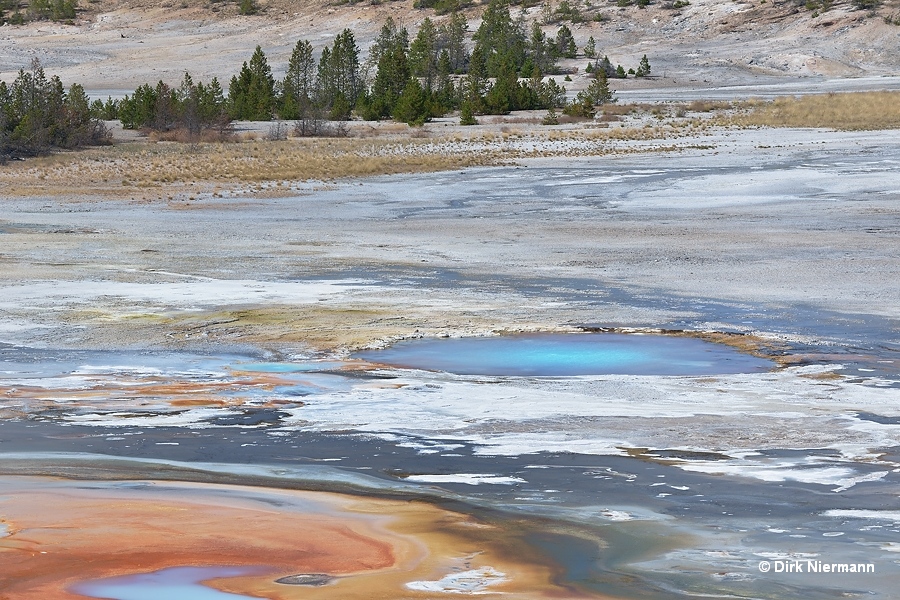
As with Blue Geyser, eruptions of Iris Spring are believed to be rare, but some may go unnoticed due to the low volume and height at a great distance.
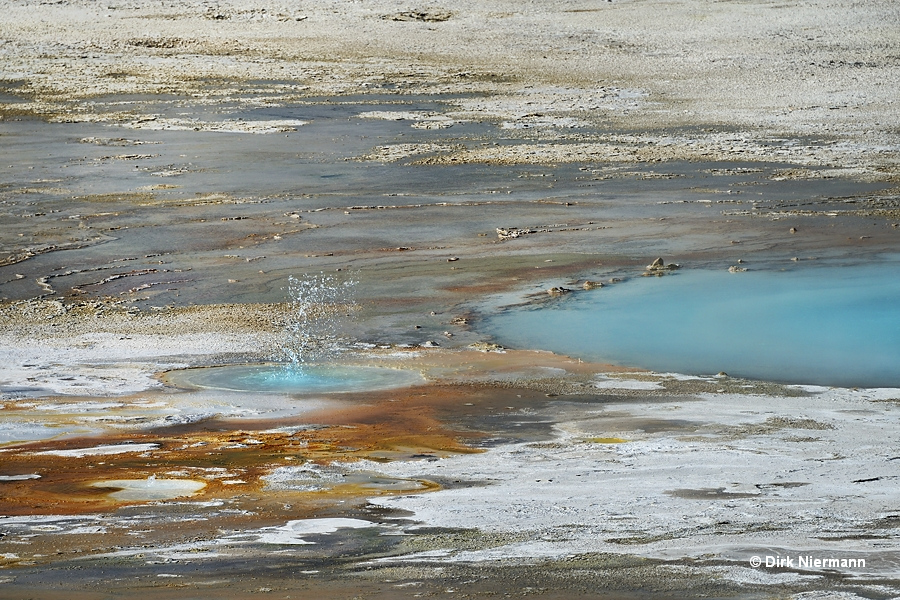
Approximately 25 m (85 feet) south of Iris Spring a somewhat larger geyser played in 2017 at an interval around 20 minutes. The diameter of the pool is estimated to be 4 m (13 feet). Especially fascinating about this geyser are the bright colors and stunning color contrast to the surrounding. The deeply orange colored film of thermophilic microbes that covers the ground around the geyser points to a neutral through alkaline environment in this spot, as found with the Porcelain Springs. In contrast, in the northwestern section of the flat acidic conditions are prevailing, recognizable by different colors and sinter structures of local springs.
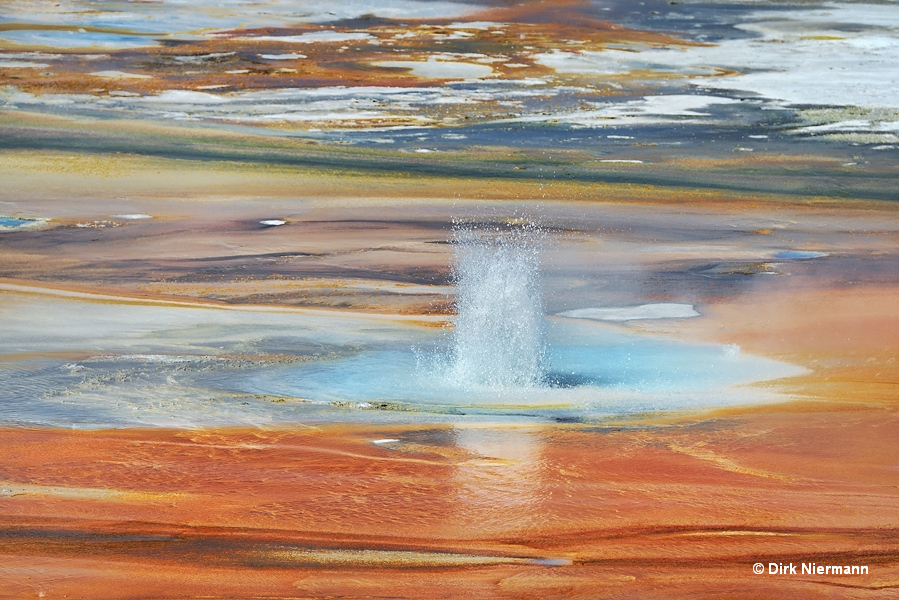
The pool visible on the pictures covers a crater with at least three different vents, perhaps more. One of them generated tiny eruptions simultaneously with the large ones.
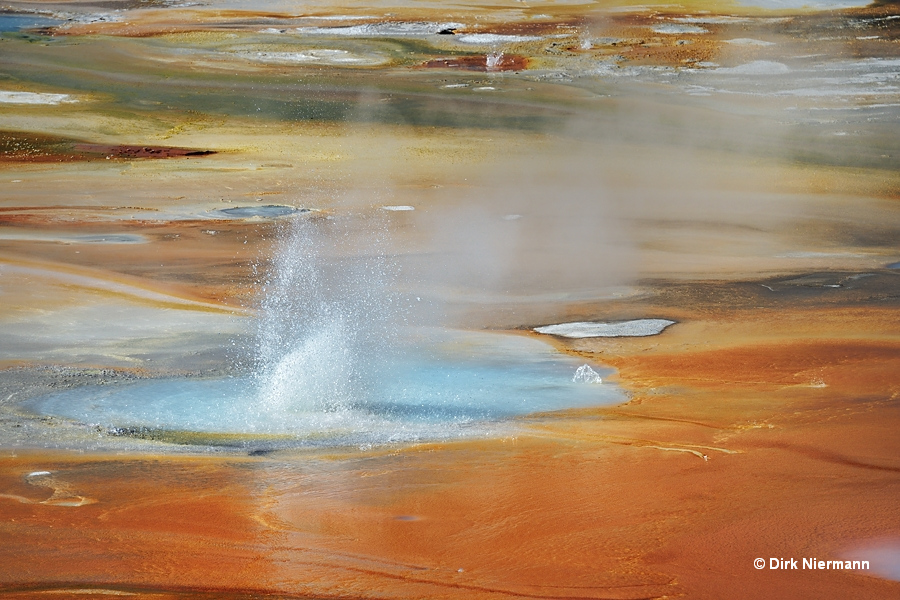
Located at nearly the same distance from Iris Spring as the geyser above, albeit in southwestern direction, the next two geysers are smaller, but they are playing together as a duo. The interval may have been around one hour. I'm quite sure that at least one or two of the geysers mentioned here do have unofficial names because some are in circulation for this section, such as Green Apple Cider Spring or Norris Geyser. But without the knowledge of experts a reliable assignment is impossible.
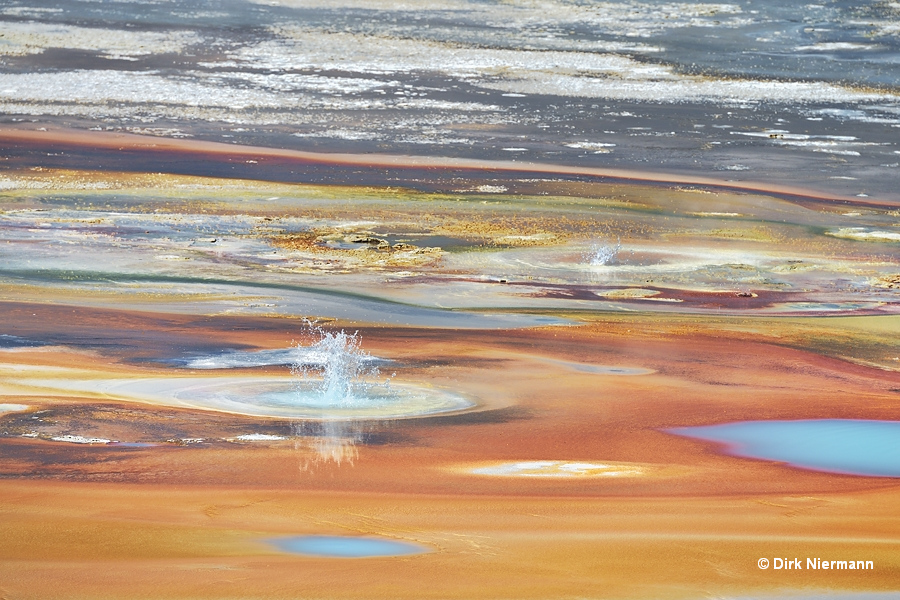
Proceeding on the initiated circle around Iris Spring to a west-northwest position, another noticeable geyser shows up, exhibiting a pool 6 m (20 feet) in diameter. In terms of appearance and colors it is completely different from the geysers described before because of its acidic nature. As an image from 1968 in the Yellowstone Digital Slide File and a map from 1929 reveal, this one is in place for a long time and bears the name Onyx Spring. According to the geyser researchers Donald E. White, Roderick A. Hutchinson, and Terry E.C. Keith, the spring is verified to be a geyser at least since 1957, and ranger Charles Phillips characterized it as a "snail geyser" in the Ranger Naturalists Manual from 1927. Apparently, already back then Onyx Spring wasn't the sprightliest one. The once black onyx color of the spring, probably caused by iron(II) sulfide, faded away and has been replaced by a light green, arising from an overlay of a yellow sulfur lining with opalescent blue water. On August 16th, 2017, Onyx Spring generated a few splashes a time with a height of approximately 50 cm (2 feet) at an interval around 20 minutes.
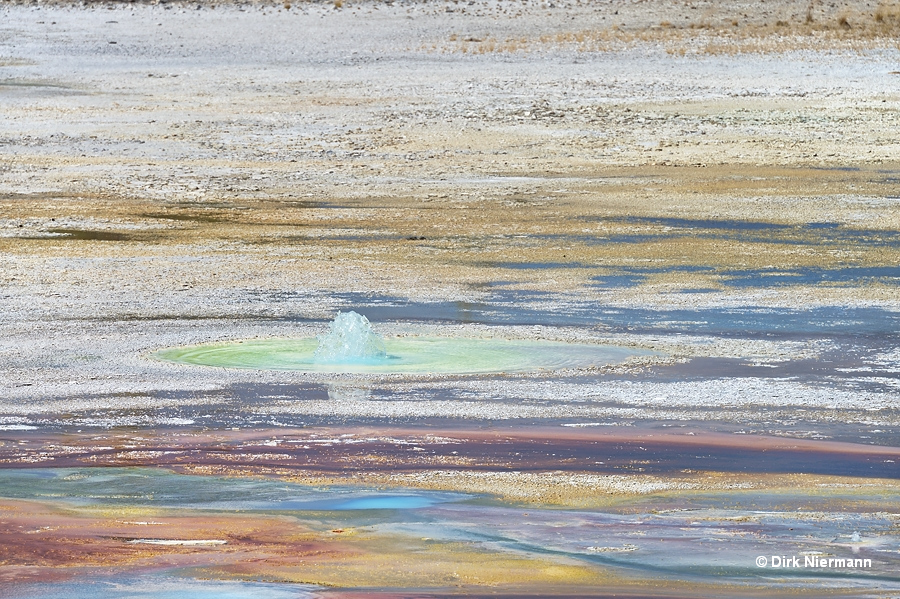
Onyx Spring was active in 2013, too, but looked a little bit different due to the missing sulfur lining. In right foreground on the next photo also the crater of the geyser south of Iris Spring is to be seen, as well as on the outer lefthand side the back then dormant, dark pair of geysers southwest of Iris Spring, all of which were discussed above.
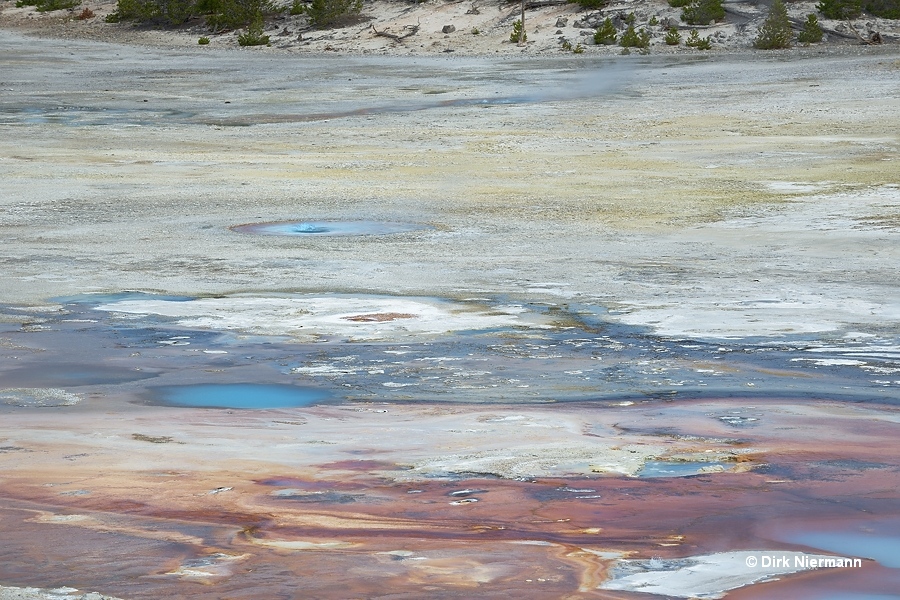
Almost at the northwestern edge of the bare flat, not far away from where the runoff of Sieve Lake enters the area, a further, somewhat larger geyser can be observed. The dome-shaped eruptions are not very high, but quite bulky.
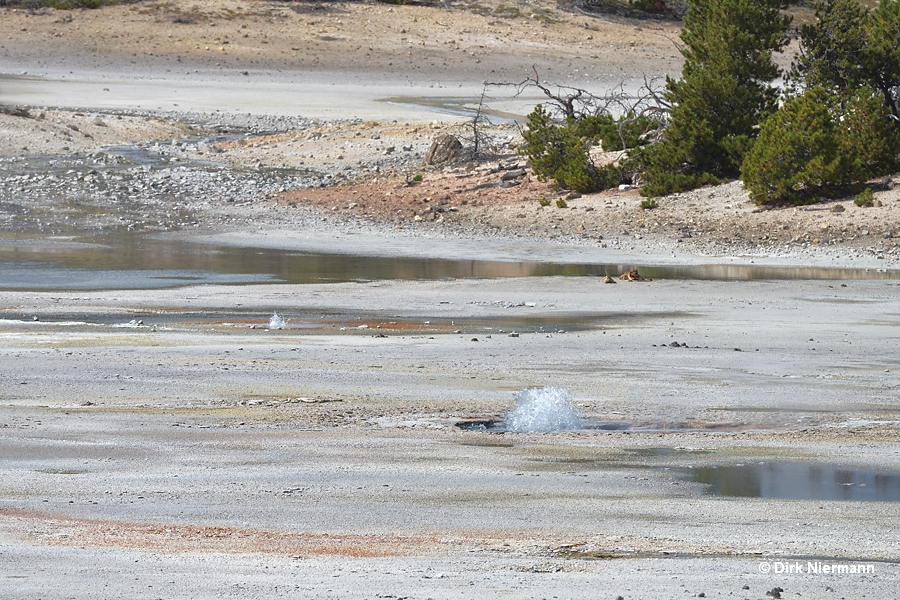
The number of tiny spouters throughout the flat of Porcelain Basin may reach a couple of dozen. In many cases, they are developing as quickly as they disappear. As an example the persistent feature NPBNN039 on a position north of Pinto Geyser and east of Pinwheel Geyser may be shown here. The salmon-colored outer ring is an often observed property of springs on the flat of Porcelain Basin and can be traced back to the presence of iron oxide at low concentrations.
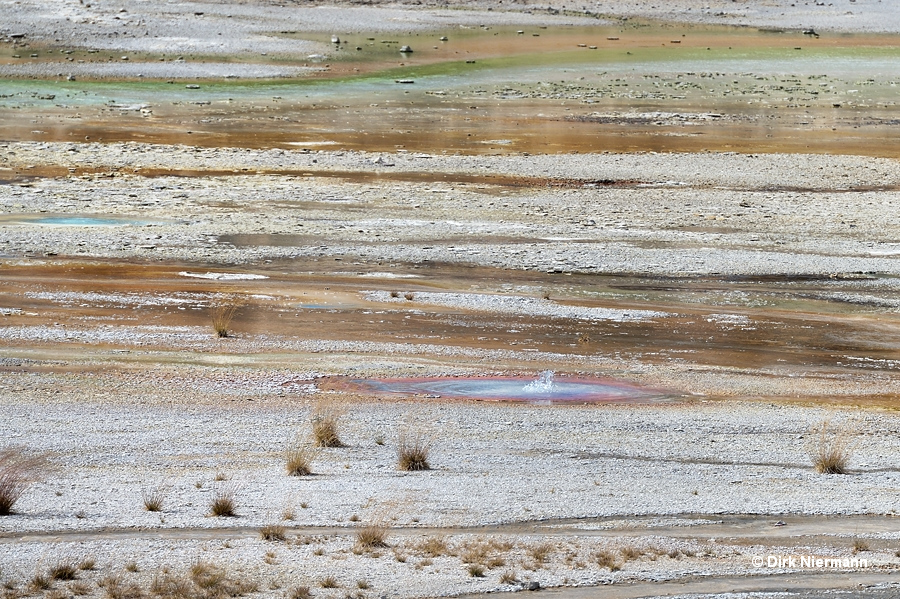
The northeast end of Porcelain Basin is marked by a range of low hills. On the slopes and on top of the hills further geysers and hot springs are to be found. A large bluish clouded pool, featuring a cave with a collapsed roof at its far side, is most eye-catching among them. The marginally visible spring is much larger than it appears, approximately as extended as Scummy Pool. The appearance of a collapsed cave could lead to a confusion with Collapsed Cave Geyser, but that one lies actually on the slope beyond it and can not be spotted from the boardwalk (many thanks to Byron Taylor for the clarification). Eruptions of Collapsed Cave Geyser may be noticed as forceful steam emissions only.
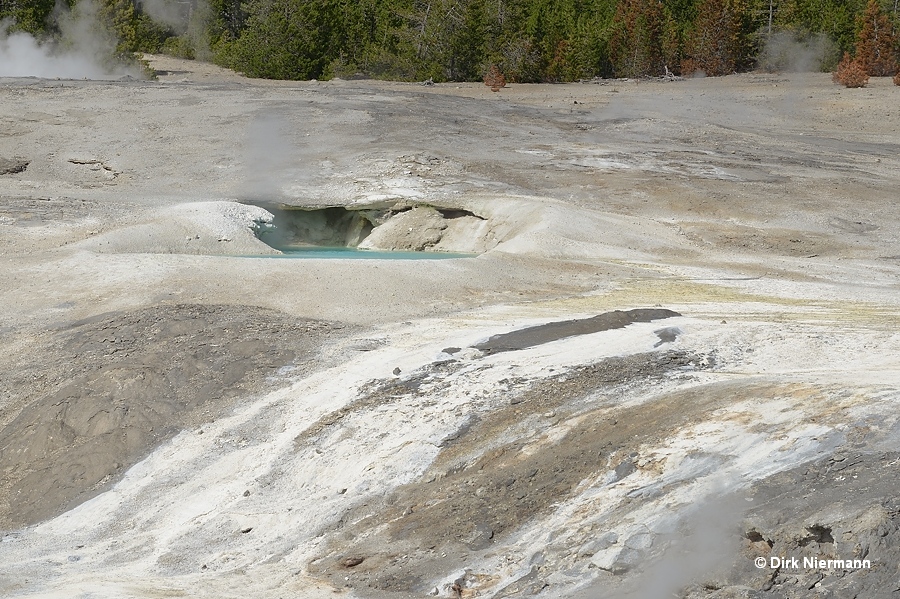
With the help of binoculars it is possible to observe geyser activity even at the remote northeast corner of Porcelain Basin. At least three unnamed geysers are active in this region.
